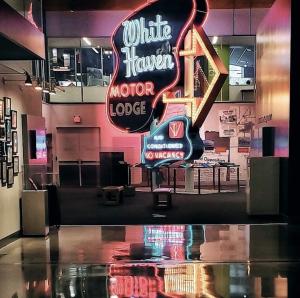History Buffs Itinerary for Overland Park
Overland Park traces its roots back to 1905 with the arrival of its founder William B. Strang Jr., who platted subdivisions, including one named “Overland Park,” along a military roadway southwest of Kansas City. Strang envisioned a self-sustaining, well planned, “park-like” community that had strong commerce, quality education, vibrant neighborhoods, convenient transportation and accommodating recreational facilities – all amenities that today, make Overland Park one of the best places to live and grow up. Below are historical stops in Overland Park.
Strang Line Car Barn
79th and Santa Fe Drive
 The Strang Line Car Barn was one of the first buildings to be constructed in Overland Park and was built by railroad magnate William B. Strang Jr. Built in 1906, the Strang Line Car Barn worked to house and repair trolleys for the Missouri and Kansas Interurban Railway, while also providing power to the electric track. Established by the founder of Overland Park, William B. Strang, the car barn operated until 1940 when the rail line was shut down and abandoned. Eventually the tracks and much of the surrounding infrastructure was demolished, but the original car barn remains. Today the building is occupied by a Traditions Furniture set to close in early 2023.
The Strang Line Car Barn was one of the first buildings to be constructed in Overland Park and was built by railroad magnate William B. Strang Jr. Built in 1906, the Strang Line Car Barn worked to house and repair trolleys for the Missouri and Kansas Interurban Railway, while also providing power to the electric track. Established by the founder of Overland Park, William B. Strang, the car barn operated until 1940 when the rail line was shut down and abandoned. Eventually the tracks and much of the surrounding infrastructure was demolished, but the original car barn remains. Today the building is occupied by a Traditions Furniture set to close in early 2023.
Strang Carriage House
Thompson Park
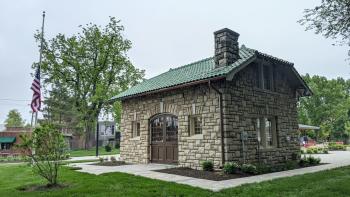 William B. Strang, Jr. is the founder of Overland Park. He purchased 600 acres of land in 1905 and developed the Strang Railroad Line, an electric interurban railroad, which become the center hub of Overland Park. The Strang Railroad provided convenient travel between downtown Kansas City and the suburbs. There is a bronze statue of Strang near 80th and Foster Street.
William B. Strang, Jr. is the founder of Overland Park. He purchased 600 acres of land in 1905 and developed the Strang Railroad Line, an electric interurban railroad, which become the center hub of Overland Park. The Strang Railroad provided convenient travel between downtown Kansas City and the suburbs. There is a bronze statue of Strang near 80th and Foster Street.
The Carriage House was built to house carriages, automobiles, and a residence for Strang's personal driver. After Strang Line Railroad discontinued service in 1940, the Carriage House sat vacant for several decades until the city bought the property in the 1970s. In the 1990s, the building was renovated to serve as the office for the Overland Park Historical Society. The building has original external features, including most of the original clay tile roof. All the large exterior doors are original. The windows have been replaced, but still match the original appearance.
Rio Theatre
80th and Floyd
The Historic Overland Theater was built in 1946. At the time, the sidewalks along 80th Street were made of wood. The price of tickets was 20 cents for children and 50 cents for adults. The old theatre is it still looks the same as it did in 1946. There have been some renovations through the years, but the original appearance remains intact.
In 1988, the city purchased the building to ensure its history was preserved. The name was changed to The Rio Theatre in 2000. The theatre is temporarily closed but exterior of the building is a good example of Art Deco design, featuring glass block, porthole windows, geometric tile, curved walls, tubular steel decoration, and mirrored columns.
The Santa Fe Trail Marker
80th and Santa Fe Drive
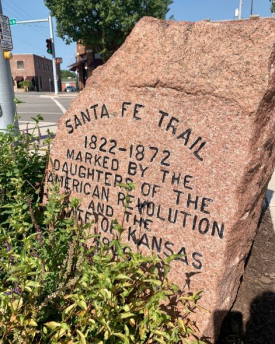 The historic Santa Fe and Oregon-California Trails are one of the most historic places in Johnson County. There is little physical evidence of the hundreds of thousands of travelers who crossed the area, but monuments and signs still mark these historic routes.
The historic Santa Fe and Oregon-California Trails are one of the most historic places in Johnson County. There is little physical evidence of the hundreds of thousands of travelers who crossed the area, but monuments and signs still mark these historic routes.
In 1902, the Kansas Daughters of the American Revolution began a campaign to place markers along the Santa Fe Trail in the state of Kansas. It was the first state to begin a campaign to mark the Santa Fe Trail. The Daughters used red granite boulders of varying sizes for the markers. By 1906, the Daughters raised enough money for 86 markers to be place through Kansas. One of those markers sits in the center of Downtown Overland Park. This marker is the first of five Santa Fe markers placed in Johnson County, Kansas.
Johnson County Museum
87th and Metcalf
A new exhibit space recently opened in the Johnson County Arts and Heritage Center, located in the former King Louie building, an Overland Park architectural icon. Here, you can browse a sizable collection of historic photos, artifacts and documents that trace Overland Park history from the late 1800s on. The newly renovated space is also home to the Johnson County Museum, where you can explore the history and heritage of the larger Johnson County community.
Winstead’s Restaurant
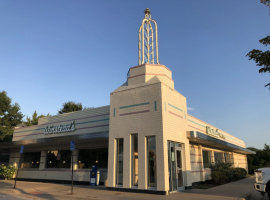 107th and Roe
107th and Roe
Winstead’s Restaurant is a beloved diner in Kansas City and Overland Park. You’ll find the original restaurant at Kansas City’s Country Club Plaza. It opened in 1940 and became an icon for its steakburgers and “skyscraper” milkshakes that serves five to six people. Only two Winstead’s restaurants remain open – the original and the Overland Park location in Mission Farms.
Frontier Military Historic Byway
 Listed on the National Register of Historic Places, the Frontier Military Historic Byway holds historical value from the turbulent times of "Bleeding Kansas" and the Civil War. The byway starts on the Kansas/Oklahoma border and runs to Leavenworth, Kansas.
Listed on the National Register of Historic Places, the Frontier Military Historic Byway holds historical value from the turbulent times of "Bleeding Kansas" and the Civil War. The byway starts on the Kansas/Oklahoma border and runs to Leavenworth, Kansas.
Running south to north on Highway 69 through Overland Park, the Arboretum & Botanical Gardens sits on the infamous byway. You can learn more about the historical byway at the Johnson County Museum.
Memorials
 Overland Park is also home to two memorial sites of lost loved ones, the 9/11 memorial and the Korean War Veteran Memorial. At the heart of the 9/11 Memorial in OP, standing 14 feet tall, is a 2.5 ton artifact from Ground Zero. “It is pretty awe-inspiring when you stand here next to it,” said Overland Park Fire Department Spokesman Jason Rhodes. “It brings back a lot of what happened that day. We want people to not only see it, but we want them to be able to walk up to it and touch it and feel it and reconnect so they can remember it."
Overland Park is also home to two memorial sites of lost loved ones, the 9/11 memorial and the Korean War Veteran Memorial. At the heart of the 9/11 Memorial in OP, standing 14 feet tall, is a 2.5 ton artifact from Ground Zero. “It is pretty awe-inspiring when you stand here next to it,” said Overland Park Fire Department Spokesman Jason Rhodes. “It brings back a lot of what happened that day. We want people to not only see it, but we want them to be able to walk up to it and touch it and feel it and reconnect so they can remember it."
The backdrop of the Korean War Veterans Memorial stands 30 granite panels engraved with the Korean War statistics, events, plaques for each of the five military service branches, a Purple Heart panel and dedication panel. Eight of those 30 panels carry the names of the 415 Kansan soldiers who were lost in the war.
Museum at Prairiefire
Prairiefire
 And the final stop of history in Overland Park is at the Museum at Prairiefire. Here you can be in awe of a full-sized Tyrannosaurus rex replica as you walk in the museum. This T-Rex replica of the real fossil at the American Museum of Natural History in New York City. You’ll see stunning archeology artifacts from national and regional collections in the main hall and a Discovery Room where kids can explore major fields of scientific research, from anthropology to zoology.
And the final stop of history in Overland Park is at the Museum at Prairiefire. Here you can be in awe of a full-sized Tyrannosaurus rex replica as you walk in the museum. This T-Rex replica of the real fossil at the American Museum of Natural History in New York City. You’ll see stunning archeology artifacts from national and regional collections in the main hall and a Discovery Room where kids can explore major fields of scientific research, from anthropology to zoology.
Overland Park Arboretum Train Garden
8909 W. 179th St.
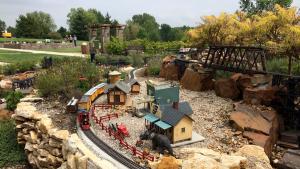 The train garden delights children and adults alike. Shrubs and flowers complement a real railroad caboose, full-size railroad crossing gate and model trains that wind through mountains, bluffs, streams, and a model of old historic Downtown Overland Park.
The train garden delights children and adults alike. Shrubs and flowers complement a real railroad caboose, full-size railroad crossing gate and model trains that wind through mountains, bluffs, streams, and a model of old historic Downtown Overland Park.


